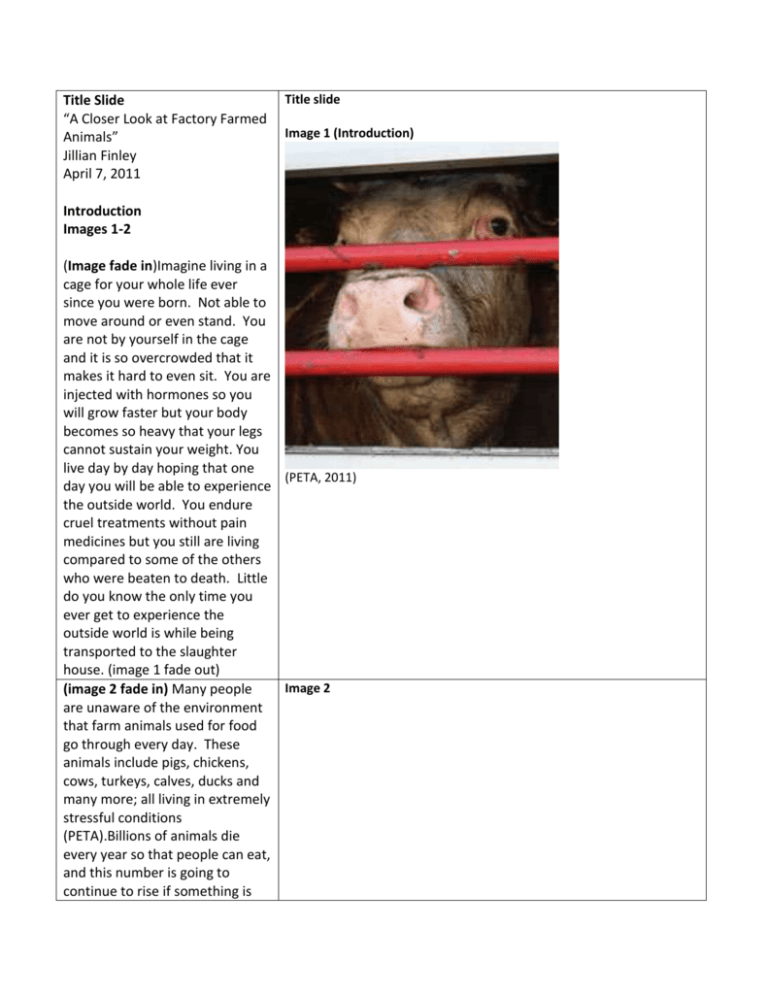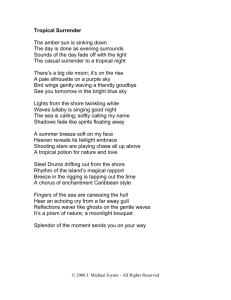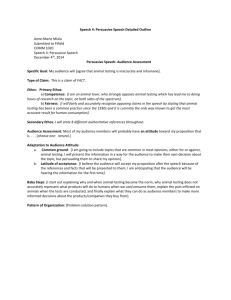Slideshow draft
advertisement

Title Slide “A Closer Look at Factory Farmed Animals” Jillian Finley April 7, 2011 Title slide Image 1 (Introduction) Introduction Images 1-2 (Image fade in)Imagine living in a cage for your whole life ever since you were born. Not able to move around or even stand. You are not by yourself in the cage and it is so overcrowded that it makes it hard to even sit. You are injected with hormones so you will grow faster but your body becomes so heavy that your legs cannot sustain your weight. You live day by day hoping that one (PETA, 2011) day you will be able to experience the outside world. You endure cruel treatments without pain medicines but you still are living compared to some of the others who were beaten to death. Little do you know the only time you ever get to experience the outside world is while being transported to the slaughter house. (image 1 fade out) Image 2 (image 2 fade in) Many people are unaware of the environment that farm animals used for food go through every day. These animals include pigs, chickens, cows, turkeys, calves, ducks and many more; all living in extremely stressful conditions (PETA).Billions of animals die every year so that people can eat, and this number is going to continue to rise if something is not done. I would like to show you what these animals have to go through and maybe it will make people realize that animal cruelty in the farming industry is not a myth.(image 2 fade out) Body (Content) Images 3-12 (Va Veg) Image 3 (image 3 fade in) On today’s factory farms, thousand of animals are crammed into small filthy crates, and other cruel confinement systems (peta). These animals will never be able to have families, free range, or do anything that is in the nature of doing. Most won’t ever be able to see the green grass or blue skies, or even feel the grass beneath their feet. Those that do are usually on their way to the slaughter house. (Image 3 fades out) (Image 4 fade in) According to PETA, “The factory farming industry strives to maximize output while minimizing costs— always at the animals' expense.” This means that these companies make more money by cramming these animals into small crates even if it may cause them harm or even death. Factory farming animals go through so much pain and suffering but to the company all that matters (Va Veg) Image 4 is that they get to the slaughter house alive; even if this means that the animal has cancer or a disease. (image 4 fade in) (Image 5 fade in) In the U.S more than 42 million cows die every year in the meat and dairy industry. Cows are very gentle and have many personalities. They like to stay together and they form relationships. Peta states that cows are very intelligent and can remember things for a long time. When these cows are very young they are branded, horns cut or burned off, and castrated without any pain killers.(Image 5 fades out, image 6 fades in) Many female cows are sent to dairy farms where they are repeatedly impregnated until they can’t anymore and then they are sent to the slaughter houses. Just like humans, cows develop maternal bonds with their calves and often the mothers cry for days when they are separated from their babies. (Image 6 fades out) (Image 7 fade in) Cattle raised for food go through many horrible things while alive. Cows are usually fed an unnatural diet so that they will fatten up and this can cause chronic stomach problems. The stomach can become so bloated that it can impair (Va Veg) Image 5 (PETA) Image 6 breathing. The diet they are fed can cause fatal liver abscesses in as many of 32% of cows. They are injected with many antibiotics so that they grow faster and to keep them alive through the horrible conditions. If the cow is sick, instead of taking them to the vet they are injected with higher doses of antibiotics just long enough until they reach the slaughterhouse. (image 7 fade out) (PETA) Image 7 (Embar, 2008) (Fade in image 8) Chickens are the most abused animals on the planet. More than 8 billion chickens are killed every year in the United States. Ninety-nine percent of those chickens live in confinement their whole life, from the moment they hatched out of their egg. (fade out image 8 and fade in image 9) (fading in image 9)There living conditions are horrible and they are crammed into sheds with sometimes up to 20,000 other chickens according to Vermont Veg. This tends to lead to outbreaks of diseases and frustration from the other chickens which can cause death to other chickens. (Fade out image 9 and fade in image 10) Image 8 (Embar, 2008) Image 9 Breeders usually end up cutting off large chunks of their beaks without painkillers so that they can’t peck at each other. Most chickens end up becoming crippled by 6 weeks of living because their legs cannot support their body weight. This happens because of all the hormones injected into them. (Fade out image 10) (Va Veg) Image 10 (Kinship Circle, 2007) (Fade in image 11) If you think all of these conditions are terrible, well it only gets worse when being at the slaughter house. The Humane Slaughter Law states that animals should be unconscious or killed before Image 11 bleeding or scalding, but in many cases these animals are still very conscious.(Image 11 fadeout, image 12 fade in) Animals are supposed to be stunned so that they don’t feel pain but the workers are poorly trained and the animals can still feel everything. Cows sometimes live (Kinship Circle, 2008) up to 7 minutes after having their Image 12 throats cuts, and chickens are still conscious when having there throat cuts but some are missed and dunked into scalding hot water. The USDA documented 14 humane-slaughter violations at one processing plant, where inspectors found hogs that "were walking and squealing after being stunned as many as four times! (Image 12 fade out) Conclusion (Images 13-17) (Flickr) Image 13 (fade in image 13)If what I have told you so far doesn’t change your mind on eating meat then think of what eating meat can do to your health. All factory farmed animals are injected with some sort of hormone to increase their growth which results in diseases, organ failure, and death. By consuming the animals you are also consuming hormones and I believe this can affect your health greatly. (Fade out image 13, fade in image 14) (image 14 fading in) Animal cruelty is not okay and there needs to be more people (Spain) Image 14 regulating to make sure that animals are not suffering and that they are being treated humanely. You can make a difference just by giving up meat or even by reducing the amount of meat you consume in a day. In our country today over consumption of meat is increasing and this is making a higher demand of animals needing to be slaughtered. (Fade out image 14, fade in image 15) (Fading in image 15) Many people become vegetarian because of all the horrible conditions those animals have to go through. Together we can help and save millions of animals’ lives by not eating factory farmed animals. And maybe one day (2009) farm animals will not have to Image 15 suffer anymore. (Fade out image 15, fade in image 16) (Fading in image 16) I would like to thank you for viewing my slideshow today and hopefully together we can make a difference. (Fade out image 16,fade in image 17) For more information on this subject and how to help please visit www.aspca.org. (Fade out image 17) Image 16 (Missfeline) Image 17 (Carpio) References People for the Ethical Treatment of Animals. 2011. Factory farming: cruelty to animals. PETA. Retrieved from: http://www.peta.org/issues/animals-used-for-food/factory-farming.aspx VA Veg. (N.d.) Animals. Explore Vegetarianism Vermont. Retrieved from: http://vegan.org/vaveg/animals/factoryfarming.htm [Cow on the way to slaughterhouse] 2011. (Image) PETA. Retrieved from http://www.peta.org/issues/animals-used-for-food/cow-transport-slaughter.aspx [Pigs in a crowded pen] N.d. (Image) Farm Sanctuary. Va veg. Retrieved from http://vegan.org/vaveg/animals/meat.htm [Cows in a crate] N.d. (Image) Farm Sanctuary. Va veg. Retrieved from http://vegan.org/vaveg/animals/eggs.htm [Chicken in a crowded cage] N.d. (Image) Farm Sanctuary. Va veg. Retrieved from http://vegan.org/vaveg/animals/eggs.htm [Lonely cow] N.d. (Image) PETA. Retrieved from: http://www.peta.org/issues/animals-used-forfood/beef-industry.aspx [Two cows in a field] 2011. (Image) PETA. Retrieved from http://www.peta.org/issues/animals-used-forfood/meat-and-environment.aspx Embar, W. (2008) Injured cow (image). Retrieved from: http://www.veganpeace.com/animal_cruelty/beef.htm Embar, W. (2008) Chicks born at a hatchery (image). Retrieved from: http://www.veganpeace.com/animal_cruelty/eggs.htm [Chickens in confinement] N.d. (Image) Farm Sanctuary. Va veg. Retrieved from http://vegan.org/vaveg/animals/meat.htm Kinship Circle.(2007) Landmark chance for farmed animals 02.(Image) Flickr. Retrievd from http://www.flickr.com/photos/smiteme/2144481110/ Kinship Circle.(2008) Animals would like president elect Obama to know. (Image) Flickr. Retrieved from: http://www.flickr.com/photos/smiteme/3076137996/ Pigs confined in metal and concrete pens. N.d (Image) Farm Sanctuary. Flickr. Retrieved from: http://www.flickr.com/photos/farmsanctuary1/2163458962/in/photostream/ Spain, J. Broiler chickens. N.d. (Image) Flickr. Retrieved from: http://www.flickr.com/photos/ciwf/3217449139/ [All animals have rights] 2009.(Image) Retrieved from: http://www.misanthropytoday.com/do-animals-have-rights/ [Go veg for the animals] N.d. (Image) Va Veg. Retrieved from http://vegan.org/vaveg/animals/animals.htm Missfeline. Stop animal cruelty. N.d. (Image) Photobucket. Retrieved from http://media.photobucket.com/image/animal%20cruelty/missfeline/StopAnimalCruelty.jpg?o=228 Carpio, R. Stop animal cruelty. N.d. (Image) Photobucket. Retrieved from http://media.photobucket.com/image/animal%20cruelty/RaquelCarpio/Animal.jpg?o=14




